SAP CPI Integration Training Online
Understanding SAP CPI: Real-Time Integration
SAP CPI requires a precise setup. As was finishing up the configuration, it became apparent that most of our time was spent finalising trailer conditions. This walkthrough wasn’t planned, but it felt necessary to help you understand SAP CPI’s process flow better.
SAP CPI was used to manage incoming messages using a content modifier. We ensured synchronised and asynchronous messages would each be handled accordingly by SAP CPI for maximum effect.
We will delve deeper into SAP CPI’s Audit service. First, we will cover how to configure it before showing you how to test it – a step that often confuses attendees. Want this part of the presentation to be clear and actionable for all.
Stay secure by protecting the Client Edict Line secret, which will inevitably come up during testing of SAP CPI processes and maintaining message flow between systems.
SAP CPIs may seem intimidating at first, especially if unexpected walkthroughs drag on past the expected timespan; yet, every second you spend learning integrations strengthens your command over them.
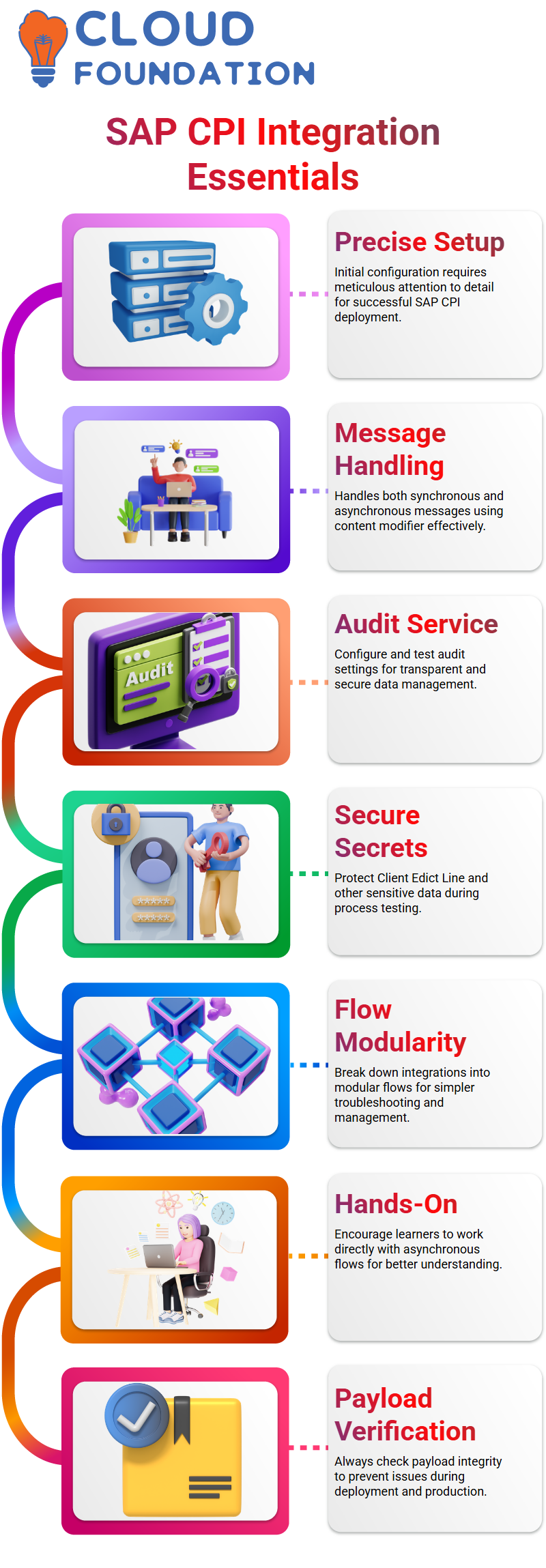
As I’ve pointed out during previous SAP CPI trainings, modularity of flows, secure secrets storage and understanding each processing step like a narrative make troubleshooting much simpler with SAP CPI.
SAP CPI is more than a middleware; it provides an environment for message orchestration. We want our next class attendees to gain hands-on experience working with asynchronous flows!
Unplanned may have exceeded all expectations, yet it laid the groundwork for greater expertise with SAP CPI in areas such as audit service settings and router configuration.
Before deploying payloads using SAP CPI, always verify their integrity. This practice can save hours during production troubleshooting and save you hours when troubleshooting occurs.
Navigating SAP CPI Cockpit and Integration Suite
After completing the initial setup, return to the SAP CPI cockpit and open the Integration Suite.
Clicking on the three-dot menu of SAP CPI suite allows exploring additional role collections; as these roles were initially invisible, use filters to filter unnecessary parameters out when searching, so they were visible before proceeding further in searching.
So we could access the SAP CPI design hub page where integration flows are created.
SAP CPI Instance Creation
SAP CPI, Adhere to proper naming conventions – something to keep handy in chat notes when creating one and any previously failed instances are deleted and restarted from scratch; give each integration plan and subtask an appropriate name, select step-by-step setup steps as instructed doing it this way helps prevent unwanted errors.
Service Keys in SAP CPI
Next, create a service key from the SAP CPI instance settings by navigating to the JSON tab and assigning. Downloaded the file that included client credentials like ID and secret.
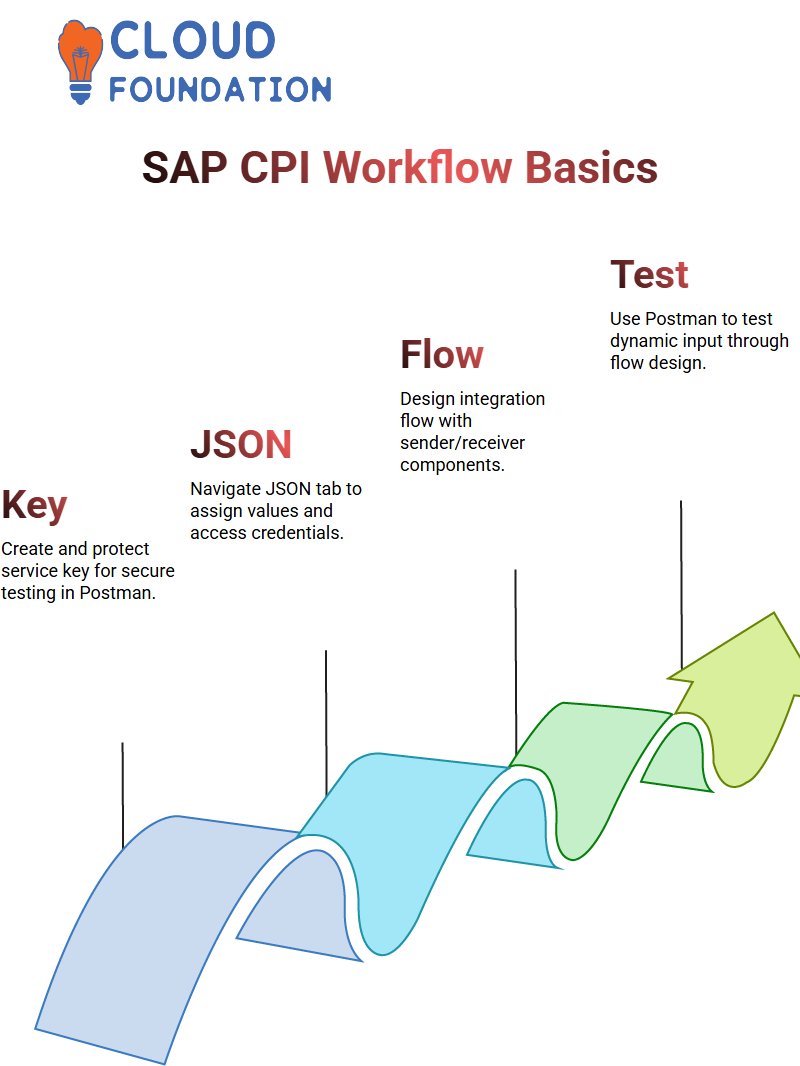
Protecting this document securely is paramount if Postman testing on SAP CPI integrations is to work effectively.
SAP CPI Integration Flow
Once roles were in place, we quickly utilised the SAP CPI design workspace. Within minutes, we created a new package, assigned it an individual name, and added an integration flow, dubbed ‘Postman Test,’ as an artefact of the integration flow design.
Within that flow design were sender/receiver components with HTTPS adapters as their adapter type, as well as content modifiers used to construct payload expressions in the standard $in—Body format, allowing for dynamic input during testing.
Understanding Value Mapping in SAP CPI
At SAP CPI, value mapping is a key concept to grasp. Unlike fixed values that provide one-to-one mappings between fields, value mapping allows us to manage multiple fields simultaneously.
This feature becomes particularly handy in complex integration situations where different systems use various codes or identifiers for data that resemble each other.
Value mapping offers us an effective solution for keeping track of varying inventory status IDs and storage locations across systems in SAP CPI, maintaining them all centrally through each entry in our value mapping table being associated with its source agency, source identifier, target agency and target identifier this ensures the correct mapping is applied according to context of integration.
Training often demonstrates this point by showing participants how to set up value mappings within integration content.

When we create or open an SAP CPI instance, we can specify which row of the value mapping table to use by selecting from four key parameters that were described earlier, providing consistency across multiple Flows.
Value Mapping in SAP CPI
Working with SAP CPI, have encountered complex scenarios where fixed-value transformation is an absolute necessity. When HR key sends us multiple values at once — say, ten different ones — we cannot simply forward them; otherwise, the target system rejects them without proper transportation.
SAP CPI can assist in solving this problem by mapping source values to their corresponding target values and creating mapping rules, thereby ensuring acceptable inputs that meet business requirements without compromising data integrity.
Two approaches exist within SAP CPI for achieving this: fixed values or value mappings.
Design SAP CPI value mappings by first creating four identifiers–source agency, source field, target agency and field. Once this step has been taken, upload values or manually construct them through the web interface.
No matter the task – from working on material accounts or monitoring flows from 2019 packages to finding existing SAP CPI value mapping artefacts easily – creating integration flows within SAP CPI is no harder!
SAP CPI enables value mapping across associated fields. For instance, mapping “FGA” from InventoryStatusID to an empty field in StockType allows functional teams to meet requirements without hardcoding across interfaces.
Fixed Values in SAP CPI Mappings
Fixed values in SAP CPI. Direct mapping alone won’t do, so keys will need to be used as transformation agents on any data that comes in from outside sources.
SAP CPI offers three mapping options: “Use Key,” “Use Default Value,” and “Throw Exception.”
For detailed mappings such as ours–where multiple source values need to be converted into specific targets–‘Use Key” should always be selected, since its precision gives more control over how each field is translated.
For example, when using SAP CPI to transform 1000 to 1, 1111 to D, and so forth, that approach is direct, precisely what our business processes demand.
Multiple HCI Fields with SAP CPI Value Mapping
Value mapping in SAP CPI simplifies life when managing 20 different HL fields simultaneously, saving time and effort by creating a single value mapping artefact that applies to multiple fields at once.
This approach saves both time and effort when managing SAP CPI’s complex fields.
Value Mapping in SAP CPI resides within your package and can be reused across HLs that require transformations.
Instead of configuring fixed values individually for every HL that needs this transformation, refer back to a central mapping – this way, everything remains organised.
SAP CPI value mapping objects provide the link between systems. Each source system and target system, along with any relevant fields, source agency, and target agency.
If InventoryStatusID = FGA, it maps to an empty value in StockType, while for InventoryStatusID = FGQ, it corresponds to “X”. This is a simple yet powerful mapping. 55
Implementing Value Mapping in SAP CPI Flows
Delve deeper into how SAP CPI enables this. In Flow’s SMS mapping component, we can reference a value mapping artefact, which instructs SAP CPI to apply specific mappings based on input values and defined source and target identifiers.
Recently, during an SAP CPI Integration, we reviewed an example in which inventory status values, such as FGA, were mapped using value mapping to select the correct row based on agency and identifier values, providing maximum flexibility for integration scenarios.
One thing to keep in mind when creating value mapping artefacts in SAP CPI is that they must exist within the same package as their flow.
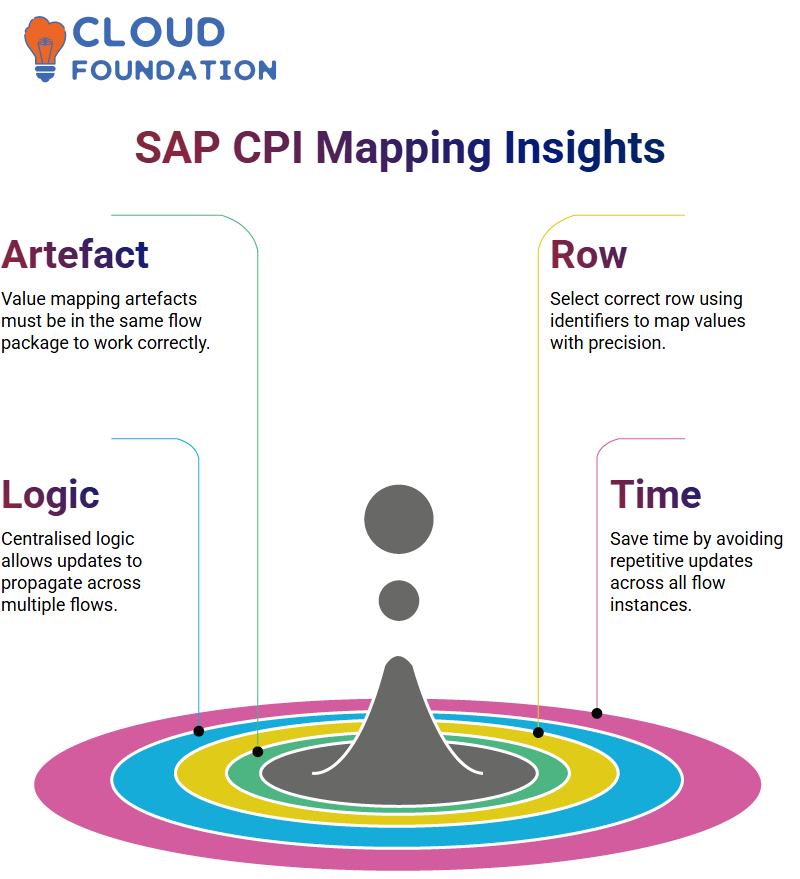
Otherwise, SAP will not be able to reference them correctly, which could prove frustrating; however, once aware, it can be easily handled.
Benefits of Value Mapping in SAP CPI
Value mapping in SAP CPI offers many advantages.
First, it centralises the logic for translating values between systems; therefore, if one value needs updating (such as FGA inventory status updates), only one place needs changing- all other Flows referenced will automatically use that updated value mapping value.
Value mapping in SAP CPI can be an enormous time-saver: imagine having 48 Flows that all use the same fixed value. Without value mapping, you’d need to update each one individually.
However, with value mapping, all updates propagate across relevant Flows at once, resulting in an efficient workflow and reduced errors.
Clarity. If someone new joins your team or needs to troubleshoot an issue, value mapping in SAP CPI provides easy visibility into how values are being assigned. This transparency should always be used whenever possible.
Scaling Transformations with Value Mapping in SAP CPI
Do another round of value mapping, this time thinking big: envision having 20 transformation logic that require fixed values configuration – going to each flow and configuring fixed mapping values is ineffective instead.
SAP CPI allows value mappings to be defined once, reused across several flows for greater error reduction, easier maintenance, faster delivery timeframe and reduced overall delivery costs.
SAP CPI makes value mappings easily manageable through dedicated packages that contain them, then reference them from any flow via a configuration step.

Find this approach particularly effective in larger implementations where consistent logic must be enforced across business units or geographies.
Message Mapping in SAP CPI
Message mapping plays a pivotal role when working with SAP CPI, helping shape how data is moved between systems.
One significant benefit of working with CPI is the ability to simulate transformations before deploying interfaces. You can test changes directly within the message mapping tool itself, ensuring everything goes as expected without going live prematurely.
When it comes to message mapping, two key concepts stand out: fixed values and value mapping. Both approaches enable us to modify values dynamically depending on our scenarios—a feature that SAP CPI facilitates through its flexible handling capabilities.
SAP CPI Mapping Tools
Through numerous projects, I’ve discovered that the power of SAP CPI’s mapping features, particularly fixed values and value mapping, is invaluable for efficiently handling transformations.
These tools give us the freedom to tackle even complex requirements quickly.
SAP CPI provides me with everything need for both one-to-one mappings and transformations with multiple targets, thanks to its flexible configuration options.
When requirements change abruptly, they can adapt quickly thanks to SAP’s intuitive structure of configuration options; hence, they find themselves coming back time and again because it works.
SAP CPI Fixed Values vs Value Mapping
Fixed values come in handy when working on an IFlow and need to hard-code some constant values for transformations, such as a transformation that always replaces one field with ‘1010’; at this point, fixed values become invaluable tools within SAP CPI.
Value mapping was specifically created to address larger scenarios. When the same transformation logic is needed across several IFlows value mapping becomes go-to approach, centralising its logic so that no further copies need to be replicated manually into every flow; SAP CPI makes this straightforward.
Understanding Message Mapping in SAP CPI
SAP CPI message mapping features enable me to convert data between formats easily. Utilising its user-friendly graphical editor, complex mappings were simplified significantly.
Furthermore, CPI provides many functions explicitly designed to manipulate strings, dates and numeric values.
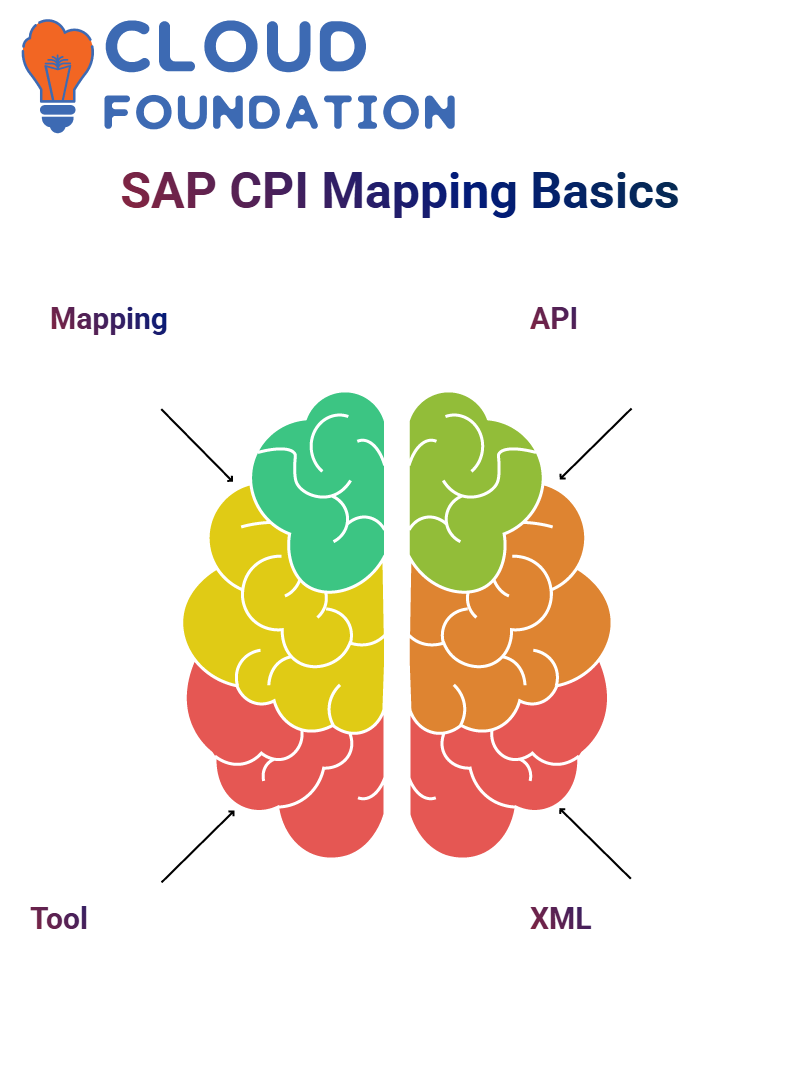 It also spent considerable time explaining how value mapping differs from fixed values and their application in various SAP CPI use cases.
It also spent considerable time explaining how value mapping differs from fixed values and their application in various SAP CPI use cases.
Working with Message Mappings and APIs in SAP CPI
The receiver system was an S/4HANA public cloud instance.
To send data from SAP CPI into S/4HANA using an API call, which required data in WSDL format, message mapping had to convert CSV inputs into suitable XML structures before submitting them for uploading into SAP.
SAP CPI made the task easier by managing this transformation through message mappings and Groovy scripts, which allowed me to customise the data before it reached its recipient.
Simulate and Test SAP CPI Mapping Logic
SAP CPI makes simulation and testing seamless, using the Display Queue to display sample file values before simulating or testing them. Do you have a file with records like 0001 or 1000? SAP CPI transforms it.
When testing in SAP CPI, set up logic that compares 1000 with one and then one to map to 1.
Monitor simulation results to verify that the transformation works as intended and ensure that each business rule is implemented accurately. This way, you will ensure that each business rule is implemented accurately.

With SAP CPI, testing doesn’t end at one field or interface; instead, it entails simulating entire flows to ensure fixed or value-based mappings work as intended across different interfaces.
Testing and Troubleshooting Value Mapping in SAP CPI
Once value mappings have been set up in SAP CPI, they must be thoroughly tested and validated to ensure accuracy.
We typically simulate the flow and verify that all desired values have been mapped correctly. In case something doesn’t go according to plan, verify that the value mapping artefact is adequately referenced with matching identifiers.
Sotis believes the issue lies with failing to convert CSV files to XML before uploading.
SAP CPI requires value mapping data in a specific format for optimal mapping results; otherwise, it won’t function, and as such, it serves as an excellent reminder to always double-check file formats before uploading anything new to SAP CPI.
Another frequent challenge related to package structure occurs when value mapping artefacts exist outside of their respective packages, rendering SAP CPI incapable of finding them.
By keeping all items contained within an SA package, this problem can be avoided.
Assigning User Roles for SAP CPI Access
Access to SAP CPI tiles requires specific role collections; therefore, navigating through the cockpit, reaching the user management section, and assigning roles (excluding viewer roles, of course) was necessary.
All relevant information, particularly regarding design and monitoring capabilities in SAP CPI, is included. Once done, logged off and logged back on to refresh permissions.
Deploying and Testing SAP CPI Flows Using Postman
Once the building and deployment of the SAP CPI flow is completed, it is saved and successfully deployed.
When using Postman to test, created a new collection with a single request that utilised SAP CPI’s client ID/secret authentication setup.
Once available, copied the URL into the GET request setup to authenticate. For basic authorisation, select Basic Auth and enter credentials before testing the endpoint successfully after deployment has taken place.
Troubleshooting SAP CPI Deployment
Unforeseen SAP CPI deployment failure can happen. When this occurs, revisit the Deployment Status Tab within the Integration Flow to assess error logs for possible solutions.
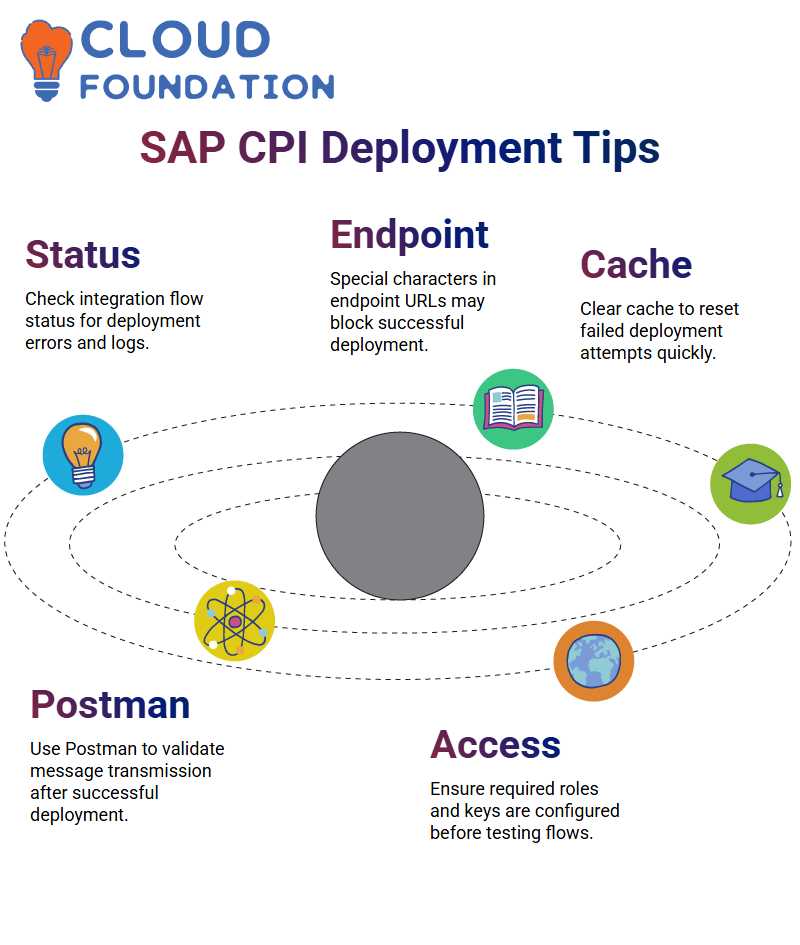 One common cause was the presence of special characters within endpoint URLs that required special attention, typically by unchecking options like CSRF token validation or temporarily changing deployment environments as necessary, or clearing the cache to provide a reset button.
One common cause was the presence of special characters within endpoint URLs that required special attention, typically by unchecking options like CSRF token validation or temporarily changing deployment environments as necessary, or clearing the cache to provide a reset button.
Finalising SAP CPI Testing Configuration
Once deployment had taken place successfully, Postman was revisited to complete the setup. Within the body tab of Postman selected “raw”, changed JSON format to text format, added simple message and hit send – watching response come through was extremely rewarding;
SAP CPI provides a practical framework and once roles, designs, service keys etc are setup it becomes easy and manageable to build, test and adapt integration flows quickly as desired.

SAP Course Price


Vinitha Indhukuri
Author

